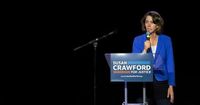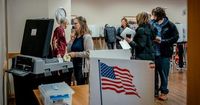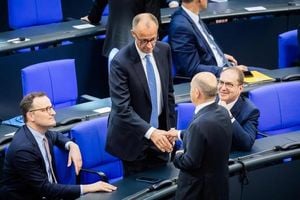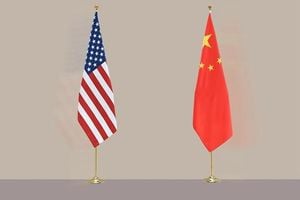In a dramatic showdown that has captivated the nation, the Wisconsin Supreme Court election concluded on April 1, 2025, with a liberal candidate emerging victorious in what has become the most expensive judicial race in American history. The contest, which saw expenditures exceed $100 million, was characterized not only by its financial stakes but also by the intense involvement of tech billionaire Elon Musk, who reportedly spent over $25 million to support conservative candidate Brad Schimel.
This election was framed as a referendum on the influence of billionaires in local politics, particularly Musk, whose financial backing of Schimel drew significant backlash from voters wary of outside interference. "Does my face say it all?" asked Lydia Vela, a 54-year-old banker, expressing her disdain for Musk's involvement. "He’s scary." Many voters, like Vela, hoped that a win for liberal candidate Judge Susan Crawford would signal a rejection of such financial meddling in state affairs.
According to reports, early voting turnout surpassed 600,000, with total participation expected to exceed two million. However, high turnout led to ballot shortages in Milwaukee, prompting election officials to scramble for additional supplies. Despite these hiccups, the enthusiasm among voters was palpable, with many citing their desire to have their voices heard in a race that could reshape the ideological balance of the state’s highest court.
The Wisconsin Working Families Party (WI WFP), which heavily backed Crawford, executed one of its largest field programs in preparation for the election. They conducted over 25,605 one-on-one conversations with voters and sent out nearly 37,000 personal postcards advocating for Crawford. Their ground game was evident as they knocked on nearly 30,000 doors and made over 190,000 phone calls to voters across the state.
Crawford, a Dane County judge and former chief counsel to a Democratic governor, is projected to win the open seat, maintaining a 4-3 liberal majority on the court. Her campaign focused on issues such as public safety, education funding, and access to healthcare, contrasting sharply with Schimel's more conservative platform. In a notable moment, Crawford, after casting her vote, chose a sticker that read "Every Vote Counts," highlighting her commitment to voter engagement.
Schimel, who previously served as the state attorney general and embraced a tough-on-crime narrative, faced challenges in garnering support amid rising dissatisfaction with the politicization of the court. Voters expressed concerns about the direction of the judiciary and the influence of money in elections. James Wampole, a 61-year-old truck driver, explained his decision to vote for Crawford, saying, "I like what she’s about. She seems like she’s the only one who’s got something in her head."
Despite Musk's aggressive financial strategy, which included offering $50 for photos of voters at polling places and significant advertising expenditures, the results of the election were a setback for his political ambitions. Democratic strategist Joe Zepecki referred to Crawford's victory as the "shot heard ’round the world," signaling a potential shift in momentum for Democrats ahead of the midterm elections.
The election's results also serve as a cautionary tale for Republicans, who had hoped Musk's involvement would help them reclaim ground in a state that has proven challenging for them in recent years. The loss was particularly poignant given the backdrop of other elections on the same day, where Republicans in Florida won two special elections for House seats but fell short of expectations based on previous Trump victories.
As voters in Wisconsin grappled with the implications of this election, many expressed a desire for a less polarized political landscape. Scott Korslin, a 47-year-old Navy veteran, noted his discontent with the ideological extremes on both sides, stating, "It’s gotten too ideological for me on both sides, too political. They just keep going further and further from the middle."
The election also included measures on the ballot related to local issues, such as a referendum to increase funding for Racine’s public schools and a proposed amendment to require photo identification for voting. The latter measure passed overwhelmingly, demonstrating the electorate's interest in securing voting processes.
Crawford's success was bolstered by substantial donations from liberal billionaires, including $1.5 million from Illinois Governor J.B. Pritzker and $1 million from financier George Soros. These contributions played a crucial role in her campaign, allowing her to compete effectively against Musk’s considerable financial backing.
In the wake of the election, the future of the Wisconsin Supreme Court remains a focal point for both parties. The new justice will be sworn in on August 1, 2025, amidst ongoing discussions about critical issues such as abortion rights and redistricting, which could significantly affect the political landscape in the state.
Overall, the Wisconsin Supreme Court election has set a new benchmark for judicial races in the United States, reflecting the growing intersection of money, politics, and public sentiment. As the dust settles, it remains to be seen how this election will influence future political strategies and voter engagement in Wisconsin and beyond.






